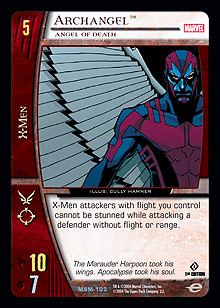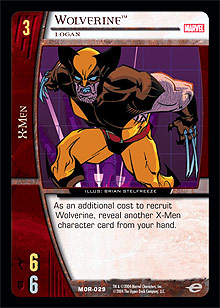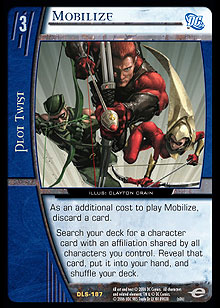This week’s Deck Clinic is a great showcase for the help that a certain rare search card from Legion of Super Heroes can give to old teams and old strategies. And what better team to start with than one of the very first teams? Cyclops, Marvel Girl, Angel, Beast, and Iceman—the students of Professor Charles Xavier at his School for Gifted Youngsters—are an unassuming bunch first brought to the attention of comic readers everywhere all the way back in 1963 and to Vs. System players not quite as far back in the Marvel Origins set.
In Vs. System, the X-Men labored for a long time with a central problem—they had no search card. They had Cerebro to help smooth their draws, but when it came to the crunch, missed drops were more of a problem for them than they were for, say, the Fantastic Four, which often forced X-Men decks to run extra characters to compensate. There have been breakout X-Men decks despite that restriction, most notably the Eugene Harvey–designed Going Rogue back at Pro Circuit Los Angeles 2004 and Michael Jacob’s Force, but such moments in the spotlight have been rare.
 What made this state of affairs particularly painful was the fact that the X-Men had some fantastic characters for certain situations—direct stuns like Gambit, Remy Lebeau and Sunfire, Shiro Yoshida; Archangel, Angel of Death for an unstunnable 10 ATK swing into characters without flight or range; discard effects like Professor X, Charles Xavier and Emma Frost, Headmistress of Xavier’s Academy. The problem was always consistency; a deck without a true search card couldn’t pick and choose which drop to hit, and would find itself stuck with the undernourished Sunfire against Curve Sentinels, or the Angel of Death against a deck full of GCPD Officers. Mobilize changes all of that. As long as you hit at least one early drop, Mobilize will be the card you always wanted when you sat down with your X-Men characters and started to pull together a deck.
What made this state of affairs particularly painful was the fact that the X-Men had some fantastic characters for certain situations—direct stuns like Gambit, Remy Lebeau and Sunfire, Shiro Yoshida; Archangel, Angel of Death for an unstunnable 10 ATK swing into characters without flight or range; discard effects like Professor X, Charles Xavier and Emma Frost, Headmistress of Xavier’s Academy. The problem was always consistency; a deck without a true search card couldn’t pick and choose which drop to hit, and would find itself stuck with the undernourished Sunfire against Curve Sentinels, or the Angel of Death against a deck full of GCPD Officers. Mobilize changes all of that. As long as you hit at least one early drop, Mobilize will be the card you always wanted when you sat down with your X-Men characters and started to pull together a deck.
All of which brings us neatly to the submission!
Submitter: darctrunks on Vs.Realms.com
Astonishingly Uncanny X-Men (Golden Age)
Characters
4 Archangel, Angel
3 Nightcrawler, Kurt Wagner
2 Jean Grey, Telekinetic Fighter
2 Longshot, Hero of Mojoworld
1 Bishop, Lucas Bishop
3 Wolverine, Logan
2 Xorn, Shen Xorn
1 Sage, Xavier’s Secret Weapon
2 Gambit, Remy Lebeau
1 Havok, Critical Mass
1 Professor X, Headmaster
1 Rogue, Power Absorption
1 Cyclops, Scott Summers
1 Colossus, Steadfast Protector
1 Sunfire, Shiro Yoshida
1 Rogue, Powerhouse
1 Storm, Weather Witch
1 Colossus, Peter Rasputin
1 Juggernaut, The Unstoppable
1 Professor X, World’s Most Powerful Telepath
1 Jean Grey, Phoenix Force
Plot Twists
4 Mobilize
4 Bamf!
4 Turnabout
4 Savage Beatdown
3 Children of the Atom
2 Betrayal
2 Fastball Special
Locations
2 Harry’s Hideaway
1 Soul World
1 Worthington Industries
1 Avalon Space Station
1 Slaughter Swamp
Well, darctrunks has certainly taken to the toolbox approach. A whopping fourteen singleton characters has to be some kind of record for a mono-team deck! It’s a pretty aggressive deck with access to both a solid curve of above average–stat characters (in addition to the toolbox of utility characters like Gambit and Sunfire), and a good block of ATK pumps in the form of Savage Beatdown and Turnabout.
The first order of business when it comes to making changes is to identify the strongest elements of the deck as it stands. I would say that the biggest strength of this deck is the ability to switch between the disruptive curve of direct stuns and discard on the one hand, and the “make enormous characters and crush your skull” plan on the other. The ability to hit a curve of Sage into Gambit into Sunfire against an off-curve deck packing Dr. Light, Master of Holograms, for example— while still retaining the ability to curve up with Wolverine, Logan; Havok, Critical Mass; Colossus, Steadfast Protector; and Rogue, Powerhouse against other curve decks—is a valuable one to have. It would be a good idea to keep all that in mind as I work.
With that out of the way, let’s take a look at the options included by darctrunks in his original list that are specifically worth noting and any that have so far been excluded.
1-drops
At the 1-drop slot, you’ll hear no argument with Archangel, Angel. The only real disincentive to running Archangel is that we have little need for more targets for his search ability than a copy or two of Worthington Industries, X-Corp.
2-drops
A point on the curve where the X-Men have traditionally been strong, there are plenty of good options here. Some of the best have already been flagged up in the original list—Nightcrawler, Kurt Wagner and The X-Men starter deck standout Jean Grey, Telekinetic Fighter. With no way to search for more “niche” 2-drops like Bishop, Lucas Bishop, I’m inclined to max out on these two rather than get diverted. If we decide not to run Archangel, then we’ll probably want a third 2-drop to try to ensure that we have an X-Man on the table on turn 3 to enable Mobilize. I’d suggest Shadowcat, Katya, whose ability to duck into and out of the hidden area makes her invaluable both as a source of emergency reinforcement and as an additional character on the board to exhaust to cards like Fastball Special. Her 3 ATK / 3 DEF stats don’t exactly hurt, either.
3-drops
 The one X-Men 3-drop that should need no introduction is Wolverine, Logan. Even with all the sets released since Marvel Origins, Logan’s 6 ATK / 6 DEF is still impressive. The availability of a fantastic disruptive option in the form of Sage, Xavier’s Secret Weapon is simply gravy. I’m going to lean toward excluding Xorn, Shen Xorn, because although his ability plays very well with others, the X-Men have access to plenty of plot twist- and location-based recovery effects that don’t require us to pass up on Wolverine’s size or Sage’s brutal resource-suppression power. While suddenly being able to toolbox at will is nice, we do need to avoid getting carried away.
The one X-Men 3-drop that should need no introduction is Wolverine, Logan. Even with all the sets released since Marvel Origins, Logan’s 6 ATK / 6 DEF is still impressive. The availability of a fantastic disruptive option in the form of Sage, Xavier’s Secret Weapon is simply gravy. I’m going to lean toward excluding Xorn, Shen Xorn, because although his ability plays very well with others, the X-Men have access to plenty of plot twist- and location-based recovery effects that don’t require us to pass up on Wolverine’s size or Sage’s brutal resource-suppression power. While suddenly being able to toolbox at will is nice, we do need to avoid getting carried away.
4-drops
This is where the multiple available “mini curves” can really take shape because the available characters become increasingly specialized. Gambit, Remy Lebeau is pretty much an auto-include, if for no other reason than his ability to stun Dr. Light, Master of Holograms before it can be activated (on turn 4 with the even initiatives, or from turn 5 onward with the odd initiatives). Rogue, Power Absorption, while unimpressive on her own, should be considered in a build running characters with particularly powerful activated powers like Sunfire, Shiro Yoshida or Emma Frost, Headmistress of Xavier’s Academy. Also, don’t forget that Rogue can steal powers from your opponent’s characters. Professor X, Headmaster provides a decent body with a card-drawing power to help fuel all the discard costs we’re racking up, and John Proudstar ◊ Thunderbird and Havok, Critical Mass fly the flag for combat addicts everywhere.
5-drops
Moving on to the 5-drops, we again find ourselves with some very distinct options. I’ve talked about Sunfire already; he pretty much sums up the benefit of Mobilize to the X-Men deck. Small for his cost, he is a complete liability in anything resembling a curve matchup. On the other hand, he’s a bona fide wrecking ball against swarm decks, either neutering Dr. Light or machine-gunning a horde of annoyances out of the way. Professor X, Charles Xavier is unfortunately feeling a little out of sorts at the moment, with cards like Mr. Mxyzptlk, Troublesome Trickster and The Phantom Stranger, Wandering Hero keeping hand sizes healthy (not to mention Soul World). The aggressive options available are more numerous and include Wolverine, The Best at What He Does; Colossus, Steadfast Protector; and Archangel, Angel of Death. We need to start being careful about uniqueness here, though. If we’re going for a beatdown curve, we will very probably have recruited Wolverine, Logan
on turn 3, and he will almost certainly still be around going into turn 5. As such, we want to steer clear of another aggressive Wolverine at this point on the curve. Let’s include the 10 ATK / 10 DEF Colossus or the 10 ATK, selectively unstunnable Archangel instead.
6-drops
Looking at the 6-drops, I have to give darctrunks props here for picking out one of the more potentially humiliating search card targets to which the X-Men have access—Storm, Weather Witch. Although she has poor stats, Storm has an ability second only to that of Koriand’r ◊ Starfire, Alien Princess against careless opponents. Bluntly, if your opponent has the initiative on turn 6 and leaves characters (particularly his or her 6-drop) in the support row, Storm has a very good chance of acting as an 11 ATK / 12 DEF walking version of The Power Cosmic, completely wrecking your opponent’s plan for the turn and effectively handing you the initiative three turns running.
Looking at more conventional options, Rogue, Powerhouse provides an auto-KO’ing, 12 ATK, flight option that isn’t named Colossus (important because an aggressive curve may well have recruited the 5-drop the previous turn). Emma Frost, Headmistress of Xavier’s Academy provides a shot of card advantage for games that are going long and two great options for activated powers that Rogue, Power Absorption can steal.
7-drops
At this point, I’m afraid, I have to go back to basics. While Juggernaut, The Unstoppable is nice, your opponent has an irritating amount of control over whether his ability will trigger. When it comes to X-Men 7-drops, I’m very strongly of the opinion that you would have to go a very long way indeed to beat Professor X, World’s Most Powerful Telepath and Wolverine, Berserker Rage. The Professor has long been respected for his ability to seriously mess up characters from Garth ◊ Tempest, Atlantean Sorcerer to Nimrod, Mutant Hunter, while also having a perfectly respectable 16 ATK for those times when attacking on curve is the order of the day. Wolverine, on the other hand, is no more or less than the perfect swarm killer. Some of the first “blowout” stories in the game’s history ended with a Wild Vomit player mournfully exclaiming, “So we went into turn 7 . . . and he had Wolverine,” and listeners wincing in sympathy at the thought of the rampaging mutant single-handedly tearing a board of a dozen characters to shreds.
8-drops
There are two characters of interest here: Professor X, Mental Master as a trump for other 8-drops (when recruited as a 9-drop himself) and specific characters like Silver Surfer, Norrin Radd; and Jean Grey, Phoenix Force, a card powerful enough to see play in decks like X-Stall and Force because of her unique ability to clear the board with a wave of her hand. Conveniently, we’re already playing the 2-drop version, making it a simple thing to satisfy her additional recruit condition. While the one-two punch of Jean followed by a boosted Professor X is nice to think about, it should be unnecessary. Once we get Jean going with Avalon Space Station, Slaughter Swamp,or Soul World, we should have little trouble putting the game away.
Building the Curve
 When it comes to condensing all of that into a character curve, it bears noting that the additional cost requirement of Mobilize to discard a card rather than a character card has some bearing on how we build the deck. Specifically, we should need to include fewer characters total—perhaps twenty-eight where we might have included thirty or thirty-two in the past. Additionally, we’ll want to weight that curve toward the low end. While hitting our 1-drop isn’t necessary, we would very much like to hit our 2-drop in every game. Considering a 1- or 2-drop as a mulligan condition, eight copies give us an 85% chance of recruiting on the first two turns. Taking that up to ten copies takes us up to 91% but leaves us less space for other characters. For now, I’m going to be somewhat conservative by adding more characters than may be needed, but I’m also going to lose Archangel, Angel.
When it comes to condensing all of that into a character curve, it bears noting that the additional cost requirement of Mobilize to discard a card rather than a character card has some bearing on how we build the deck. Specifically, we should need to include fewer characters total—perhaps twenty-eight where we might have included thirty or thirty-two in the past. Additionally, we’ll want to weight that curve toward the low end. While hitting our 1-drop isn’t necessary, we would very much like to hit our 2-drop in every game. Considering a 1- or 2-drop as a mulligan condition, eight copies give us an 85% chance of recruiting on the first two turns. Taking that up to ten copies takes us up to 91% but leaves us less space for other characters. For now, I’m going to be somewhat conservative by adding more characters than may be needed, but I’m also going to lose Archangel, Angel.
That said, here’s my first draft of the curve:
4 Jean Grey, Telekinetic Fighter
4 Nightcrawler, Kurt Wagner
2 Shadowcat, Katya
4 Wolverine, Logan
3 Sage, Xavier’s Secret Weapon
1 Gambit, Remy Lebeau
1 Professor X, Headmaster
1 Rogue, Power Absorption
1 Havok, Critical Mass
2 Colossus, Steadfast Defender
1 Sunfire, Shiro Yoshida
1 Rogue, Powerhouse
1 Storm, Weather Witch
1 Emma Frost, Headmistress of Xavier’s Academy
1 Professor X, World’s Most Powerful Telepath
1 Wolverine, Berserker Rage
1 Jean Grey, Phoenix Force
The deck is heavily weighted toward the lower end of the curve at present and will almost certainly be running multiple copies of Worthington Industries to keep the characters coming. The 4-drop slot is probably the one at which the differentiation between characters for particular matchups is most important, so it’s the most obvious “toolbox” point on the curve. While the 6-drops look just as differentiated (that is, a bunch of one-ofs), it will usually be less important to hit a particular 6-drop in any given matchup. That doesn’t mean that given the choice you wouldn’t want a specific one, of course; it’s just that you can tolerate recruiting Storm over Rogue in a way that you can’t tolerate recruiting Rogue over Gambit when you need to keep Dr. Light down. Thirty characters is certainly fewer than a mono-X-Men deck could ever have reasonably gotten away with in the past, and the extra deck space that a search card like Mobilize allows is a bonus on top of the fact that, well—it’s a search card. Worthington Industries, even without Archangel, should provide a useful supplement, filtering through our deck for characters (especially if we retain the locations that can return character cards from our KO’d pile) and keeping our curve consistent.
Tomorrow, I’m going to take a good look at the plot twists, locations, and equipment available to the deck and make any necessary changes to the character roster before settling on a final build.
Tom Reeve is a member of the Anglo-Canadian Alliance (like the Rebel Alliance, but with public transport instead of X-Wings) and would-be professional layabout from London, England. While his love of all things ninja has resulted in an arguably unhealthy affinity for the League of Assassins, that particular quirk turned into a healthy plus with the birth of the Silver Age deck Deep Green, with which teammate Ian Vincent took home the Pro Circuit San Francisco trophy to dear old Blighty.